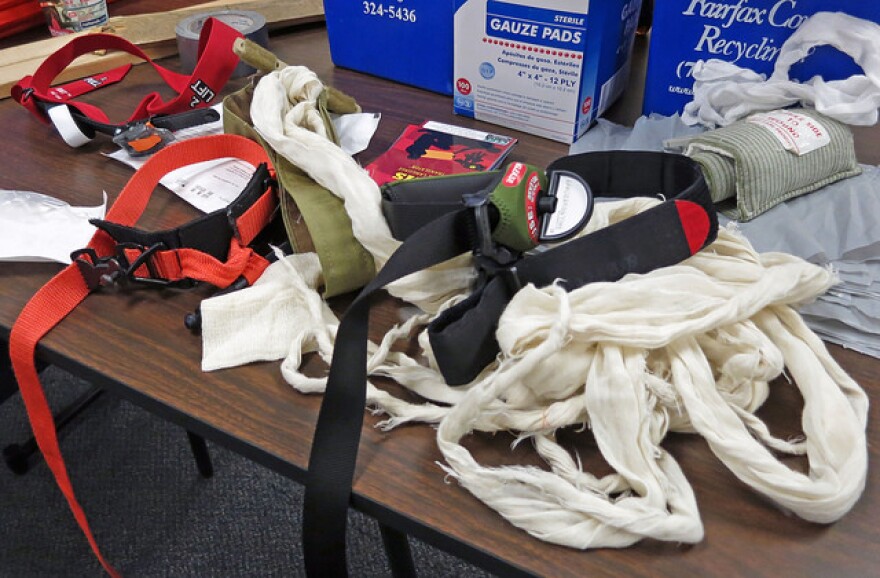Doctors say when it comes to trauma, bleeding out is the most preventable cause of death – and it typically happens before patients even make it to the hospital. With a rise in multiple-casualty events like the recent shootings in Washington and Houston and stabbings in Minnesota, one program aims to change the role of bystanders.
Amanda Stallings fastened a tourniquet onto her co-worker Michael Overton, looping it around his bicep, two inches above his elbow. She tightened a black strap, like a belt, and turned a plastic lever until Overton let out a strained yelp. “That’s good!” he said in between her apologies.Putting on a tourniquet is one thing she hopes she’ll never have to do outside this conference room.
Stallings is not a medical professional. In fact, she’s never even touched a tourniquet before. She’s executive director of the John Peter Smith Foundation in Fort Worth. She was taking a course in bleeding control as part of a national program called “Stop the Bleed,” piloted in Fort Worth by JPS Health Network.
It’s not like in the movies. “There were a lot of takeaways, a lot of misconceptions that were dispelled,” Stallings said.
This story comes from KERA, Houston Public Media.
Like how you have to stuff gauze deep into an open wound to control bleeding – not just put pressure on it – and how everyday items can’t be tightened enough to use as tourniquets.“I didn’t know you couldn’t use a belt or a shoelace, or ripping up a T-shirt and tying it around an arm, to act as a tourniquet,” Stallings said.
It’s the stuff you see in the movies, she said. And the goal of “Stop the Bleed” is to not only put those myths to rest, but to also arm everyday people with the knowledge and skills they can use in an emergency: a car crash, a mass shooting, even a terrorist attack.
“The public wants to do something proactive,” said Mary Ann Contreras, a registered nurse at JPS and a “Stop the Bleed” trainer. “At JPS, we can go out, and we can teach the public how to do something, how they can control and maybe change a situation that begins very badly, but perhaps ends on a positive note where people don’t die.”
Over the course of two hours, students learn the basics of bleeding control and then get to practice techniques on each other.
“We teach the community how to look at the bleed, how to recognize it, how to protect themselves from blood-borne pathogens, and how to apply direct pressure,” Contreras said. “How to utilize a tourniquet, how to even pack wounds for a deep bleed that’s more difficult to stop.”
“Stop the Bleed” kits include three tourniquets, an elastic child tourniquet, gloves and a special gauze that’s infused with blood-clotting medicine. Contreras said the supplies are easy to find in most camping stores, and a whole kit costs about $175.
The goal is to put one of these kits everywhere there’s an automated external defibrillator, as well as encourage as many people as possible to keep these supplies in their cars. Contreras said she hopes the program becomes as widespread as first-aid and CPR training.
“No one should die out in the community from bleeding to death. There’s no reason for that,” she said.
‘It’s a life-saving program’
Dr. Raj Gandhi is the trauma medical director at JPS and leads “Stop the Bleed” training.
“About a third of the deaths occur before the patient even gets to a hospital. So you have a large patient population that can be saved from some simple measures,” Gandhi said.
The program was adapted from lessons learned in the military, and in recent years, Gandhi said, it’s become more pertinent to civilians, especially with mass shootings and multiple-casualty events becoming more common. “Stop the Bleed” wasformally endorsed by the White Houselast October.
“It is a life-saving program, and we want to distribute it to as many places as possible because we never know who we’re going to be able to help and at what time,” he said. For Amanda Stallings, that’s priceless knowledge.“Unfortunately, we live in a world where you see traumas unfold each and every day,” she said. “This is very valuable, something I’ll able to share with my family and tell my friends.”
And her co-worker, Michael Overton, is now confident he’ll be able to help in an emergency.
“The raw carnage involved in these situations is sobering and shocking, and you just don’t expect to see someone with a wide-open leg, but when it’s there, what are you doing to do?” Overton said.“Stop the Bleed” is helping people answer that question with two free classes a month at John Peter Smith Hospital in Fort Worth.




